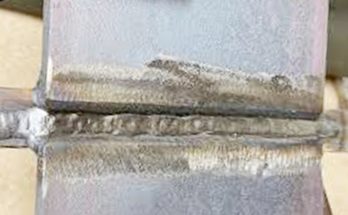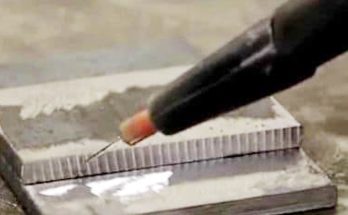Welding stainless steel with flux core can be a game-changer, especially when working in outdoor or windy conditions where gas-shielded welding isn’t an option. I’ve spent a good amount of time dialing in the right settings, and I know firsthand that getting them wrong can lead to excessive spatter, weak welds, and a whole lot of frustration.

Image by Zac Burnes fb
When you get everything set up properly, stainless steel flux core welding can produce strong, durable joints without needing an external shielding gas.
If you’re looking to master stainless steel flux core welding settings, this guide will walk you through everything you need to know. From selecting the right wire to adjusting voltage, wire speed, and polarity, I’ll cover all the key details to help you get the best results.
Can You Weld Stainless Steel with Flux Core?
Yes, you can weld stainless steel with flux core wire, but you need to use the right type of stainless flux-cored wire. Unlike standard MIG welding, which requires a shielding gas, flux-cored welding uses a self-shielding wire that creates its own gas as it burns. This makes it a good choice for welding outdoors or in areas with poor ventilation, where using a gas tank might not be practical.
Choosing the Right Stainless Steel Flux Core Wire
The type of wire you use plays a huge role in how well your weld turns out. Here are some of the most common options:
| Wire Type | Best For | Gas Required? |
|---|---|---|
| E308LT-1 | Welding stainless steel to stainless steel (304, 308 grades) | No (Self-Shielded) |
| E309LT-1 | Welding stainless steel to mild steel | No (Self-Shielded) |
| E316LT-1 | Marine and high-corrosion environments | No (Self-Shielded) |
If you’re welding stainless to stainless, go with E308L. If you need to weld stainless to mild steel, then E309L is the better choice because it helps prevent cracking and corrosion between the two different metals.
Ideal Settings for Stainless Steel Flux Core Welding
Getting the right settings is critical to achieving strong and clean welds. The best voltage, wire speed, and amperage settings depend on the wire diameter and metal thickness. Here’s a basic reference:
| Wire Diameter | Material Thickness | Voltage (V) | Amperage (A) | Wire Speed (IPM) |
|---|---|---|---|---|
| 0.030″ | 16-12 gauge | 17-19V | 80-140A | 200-300 IPM |
| 0.035″ | 12-10 gauge | 19-21V | 140-180A | 250-350 IPM |
| 0.045″ | 10 gauge – 1/4″ | 21-25V | 180-250A | 300-450 IPM |
These numbers give you a solid starting point, but always adjust based on your specific setup. If you’re seeing too much spatter, you may need to lower your voltage or adjust your wire speed.
Polarity Settings for Stainless Steel Flux Core Welding
The correct polarity for flux-cored stainless steel welding is:
- DC Electrode Positive (DCEP) – For most gas-shielded flux core welding.
- DC Electrode Negative (DCEN) – For some self-shielded flux core wires.
Most stainless steel flux core wires are self-shielded, meaning they don’t require an external shielding gas, and they typically run best on DCEN polarity. But always check the manufacturer’s recommendations for your specific wire type.
Welding Techniques for the Best Stainless Steel Welds
Getting a clean and strong weld isn’t just about the settings—you also need the right technique. Here are a few things that have helped me get better results:
- Maintain a Short Arc Length – Keeping your arc length as short as possible helps with penetration and reduces spatter.
- Use a Drag (Pull) Technique – For flux core welding, dragging the gun at a 10-15° angle usually works best.
- Control Your Travel Speed – Move slowly enough to allow full penetration but not so slow that you build up too much heat and warp the metal.
- Use Multiple Passes for Thicker Metal – If you’re welding anything over 1/8″, multiple passes will help prevent defects.
Common Issues and How to Fix Them
Even with the right settings, you might run into some issues. Here’s a breakdown of the most common problems and how to fix them:
| Issue | Cause | Solution |
|---|---|---|
| Excessive Spatter | Voltage too high or wire speed too fast | Lower voltage and adjust wire speed |
| Porosity (Holes in the Weld) | Contaminants or improper shielding | Clean the metal thoroughly before welding |
| Weld Cracking | Wrong filler metal or too much heat | Use the correct stainless wire and reduce heat input |
| Poor Penetration | Low amperage or too fast travel speed | Increase amperage and slow down slightly |
Shielding Gas vs. No Gas: Do You Need One?
One of the main advantages of flux core welding is that self-shielded wires don’t require gas, making them convenient for outdoor use. However, some stainless steel flux core wires are dual-shielded, meaning they can be used with CO₂ or argon-CO₂ gas mixtures for cleaner welds.
Here’s when you might want to use gas:
- For a cleaner weld appearance – Gas-shielded flux core welding reduces slag and gives a neater weld.
- When welding indoors – If you’re in a controlled environment, gas-shielded welding can produce stronger, higher-quality welds.
- For critical applications – If the weld needs to meet strict standards, gas can help ensure a more reliable joint.
If you don’t have access to gas or need to weld outdoors, self-shielded stainless flux core wire is the way to go.
Applications of Stainless Steel Flux Core Welding
This type of welding is commonly used in:
- Automotive Work – Exhaust pipes and structural repairs.
- Construction and Structural Welding – Outdoor stainless steel structures.
- Food Industry Equipment – Stainless kitchen and processing equipment.
- Marine and Chemical Applications – Corrosion-resistant repairs.
If you’re working in environments where corrosion resistance is important, stainless steel flux core welding is a solid option.
Conclusion
Stainless steel flux core welding is an excellent method when gas-shielded welding isn’t practical. By using the right wire type, voltage, amperage, and polarity, you can achieve strong, reliable welds even in challenging conditions.
The key to success is fine-tuning your settings based on the material thickness and wire diameter. If you’re new to this type of welding, take the time to practice on scrap pieces before working on your actual project. With the right adjustments and a bit of patience, you’ll get the clean, durable welds you need.
FAQs
What is the best wire size for stainless steel flux core welding?
0.030″ or 0.035″ wire is best for most applications, while 0.045″ is good for thicker materials.
Should I use shielding gas for stainless steel flux core welding?
Not always. Most stainless flux core wires are self-shielded, but some can use gas for cleaner results.
What polarity should I use for stainless steel flux core welding?
Most stainless steel flux core wires run on DCEN (Electrode Negative). Always check your wire specifications.
Why is my weld full of spatter?
High voltage, incorrect polarity, or excessive wire speed can cause spatter. Adjust these settings to reduce it.
Once you get the settings dialed in, stainless steel flux core welding becomes a powerful tool for strong and corrosion-resistant welds. Keep experimenting with your settings, and happy welding!


